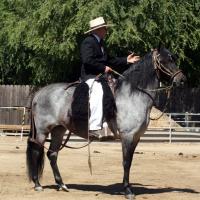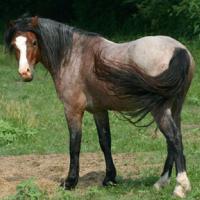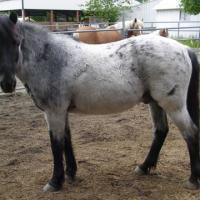Classic Roan in Horses
Classic Roan Visual Identification
Classic Roan is a white pattern that causes white hairs to be distributed throughout the coat but leaves the face and lower legs solid. It also causes characteristic inverted V shapes just above the knees. Classic Roan is inherited as a Simple Dominant. This means that if a horse is roan one of it’s parents must have been roan as well. However, like all white patterns the expression of Classic Roan can vary. An example of this is Genuine Roy an Australian stallion, who did not himself appear to be roan. Genuine Roy had classic roan offspring out of non-classic roan mares and at least one offspring tested positive for classic roan marker while his dam mare did not. While Genuine Roy himself was never tested, when add to his other classic roan offspring, this makes a very convincing case for Genuine Roy being a very minimal Classic Roan. This is a very rare occurrence however, and can most likely be attributed to a some sort of white suppression. The same as having a minimal tobiano or minimal frame, you can have a minimal roan.
Classic Roans tend to be darker in the winter and more roaned during the summer. This seems to be caused by different lengths of hair being affected differently by roan. The long coarse hairs of the winter coat are less affected by roan than the shorter under coat. Part the long winter coat of a roan and the white hairs of the undercoat are still visible just hidden by the longer hairs. This can clearly be seen in the spring when many roans go almost complexly white as they shed the longer guard hairs before the shorter undercoat. Roans sometimes have what are called "corn marks" these are darker areas in the coat often where the horse has received a bite or other minor injury. When the hair regrows after the injury, it tends to be less roaned than the surrounding areas. Because roan is a white pattern, any base color can be roan. Bay roan, Black (often called Blue) roan, and red (strawberry) roan are the most common but other combinations such as Palomino roan and Dun Roan are not uncommon.
The identification of classic roan in foals can be difficult as classic roan is generally not discernible in the foal coat. It does sometimes leaves telltale white hairs in the foals flanks but other patterns can do this as well. It is when the foal coat is shed that the classic roan pattern can be positively identified.
A dun roan foal during his foal shed. Notice how the foal coat has almost no roaning. It was impossible to tell that this particular foal was roan until he started to shed.
For more images of Classic Roan Horses please visit the Classic Roan Photo Gallery.
Which Breeds Have Classic Roan?
According to UC Davis, Roan is know to be present in “Quarter Horses, Paints, Peruvian Paso, Paso Fino, Welsh Pony, Miniature and Belgian”. It is however, also present in The Rocky Mountain Horse, Tennessee Walking Horses, Missouri Fox Trotters, Percherons, The Murgese Horse, American Shetlands, UK Shetlands, Icelandics, and Brabants and probably other breeds. Historically it was present in Lipizzaners (as visible in the painting "The Imperial Stud with Lipizzaner Horses") and may still be present under the gray. Linda V is a Lipizzaner mare that appears to be classic roan.
The Genetics of Classic Roan
For many years classic roan was thought to be embryonic lethal when homozygous. This was due to a 1979 study (Hintz; van Vleck. "Lethal dominant roan in horses". Journal of Heredity 70: 145–6.) of Belgian horses that found roan to roan breedings produced fewer roan offspring than expected. This lead the researchers to conclude that roan was homozygous lethal in utero. It is not known at this time what caused the number skew in this study. However, the existence of homozygous roans has been proven by the production records of several American Quarter Horse stallions, and also by testing at UC Davis (with the marker test).
Although roan was mapped to the KIT gene way back in 1998, the causative mutation has yet to be found. UC Davis has identified two allelic “markers”. These markers are pieces of DNA that are linked to roan but not the actual roan mutation. Marker tests are not 100% accurate but do provide a good estimate of whether roan is present especially when DNA from the animals parents is available for testing as well. The fact that UC Davis has identified two different markers may indicate that there is more than one mutation causing the classic roan pattern.
Since roan is a KIT gene mutation, a horse cannot be homozygous for roan and also carry a third KIT gene allele (or homozygous for any other KIT gene mutations and also carry classic roan) without additional mutations having taken place. Only two alleles of each gene are possible. This mean that if in order for a horse to be both homozygous Roan and say Tobiano, Tobiano would have to be linked with and always travel with one of the roan alleles creating a single allele (that carries two separate mutations). Such mutations are rare but have been known to happen in other species.
Classic Roan Look Alikes
There are several patterns that are often confused with classic roan. The most common of these is probably gray. Gray is not actually a white pattern but a modifier that causes a progressive whitening of the coat throughout the life of the horse. Many gray horses are solid white in advanced age. Gray is often confused with Classic Roan because it’s early presentation of white hair mixed into the coat. Gray rarely presents with a solid face however. This, and it’s progressive nature, help to distinguish it from roan. Other patterns that can be confused with Classic Roan are Leopard Complex, Sabino, Rabicano and other KIT gene mutations. All of these patterns also cause “roaning”, which is a distribution of white hairs throughout the coat, but differ somewhat in appearance. The key point to remember in distinguishing these patterns and Classic Roan is Classic Roans solid face, lower legs, and the inverted V’s on the knees.
Classic Roan and Catch A Bird
Catch A Bird was a thoroughbred stallion that possessed a unique brindle coat pattern. Several of his offspring were born with a classic roan type pattern. These offspring of Catch A Bird are the only true roan thoroughbreds in existence. Although many thoroughbreds are called Roan, the term roan in thoroughbreds is used to indicate gray. This can cause confusion as gray is sometimes confused with roan even without the naming difficulties.




Thanks to Lewella Tembreull
Thanks to Lewella Tembreull who pointed out that I had missed American Shetlands, UK Shetlands, Icelandics, and Brabants in the breed list